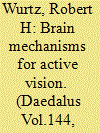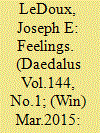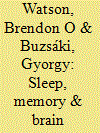| Srl | Item |
| 1 |
ID:
137655


|
|
|
|
|
| Summary/Abstract |
Active vision refers to the exploration of the visual world with rapid eye movements, or saccades, guided by shifts of visual attention. Saccades perform the critical function of directing the high-resolution fovea of our eyes to any point in the visual field two to three times per second. However, the disadvantage of saccades is that each one disrupts vision, causing significant visual disturbance for which the brain must compensate. Exploring the interaction of vision and eye movements provides the opportunity to study the organization of one of the most complex, yet best-understood, brain systems. Outlining this exploration also illustrates some of the ways in which neuroscientists study neuronal systems in the brain and how they relate this brain activity to behavior. It shows the advantages and limitations of current approaches in systems neuroscience, as well as a glimpse of its potential future.
|
|
|
|
|
|
|
|
|
|
|
|
|
|
|
|
| 2 |
ID:
137676


|
|
|
|
|
| Summary/Abstract |
Traditionally, we define “emotions” as feelings and “feelings” as conscious experiences. Conscious experiences are not readily studied in animals. However, animal research is essential to understanding the brain mechanisms underlying psychological function. So how can we make study mechanisms related to emotion in animals? I argue that our approach to this topic has been flawed and propose a way out of the dilemma: to separate processes that control so-called emotional behavior from the processes that give rise to conscious feelings (these are often assumed to be products of the same brain system). I will use research on fear to explain the way that I and many others have studied fear in the laboratory, and then turn to the deep roots of what is typically called fear behavior (but is more appropriately called defensive behavior). I will illustrate how the processes that control defensive behavior do not necessarily result in conscious feelings in people. I conclude that brain mechanisms that detect and respond to threats non-consciously contribute to, but are not the same as, mechanisms that give rise to conscious feelings of fear. This distinction has important implications for fear and anxiety disorders, since symptoms based on non-conscious and conscious processes may be vulnerable to different factors and subject to different forms of treatment.
|
|
|
|
|
|
|
|
|
|
|
|
|
|
|
|
| 3 |
ID:
137672


|
|
|
|
|
| Summary/Abstract |
Sleep occupies roughly one-third of our lives, yet the scientific community is still not entirely clear on its purpose or function. Existing data point most strongly to its role in memory and homeostasis: that sleep helps maintain basic brain functioning via a homeostatic mechanism that loosens connections between overworked synapses, and that sleep helps consolidate and re-form important memories. In this review, we will summarize these theories, but also focus on substantial new information regarding the relation of electrical brain rhythms to sleep. In particular, while REM sleep may contribute to the homeostatic weakening of overactive synapses, a prominent and transient oscillatory rhythm called “sharp-wave ripple” seems to allow for consolidation of behaviorally relevant memories across many structures of the brain. We propose that a theory of sleep involving the division of labor between two states of sleep–REM and non-REM, the latter of which has an abundance of ripple electrical activity–might allow for a fusion of the two main sleep theories. This theory then postulates that sleep performs a combination of consolidation and homeostasis that promotes optimal knowledge retention as well as optimal waking brain function.
|
|
|
|
|
|
|
|
|
|
|
|
|
|
|
|